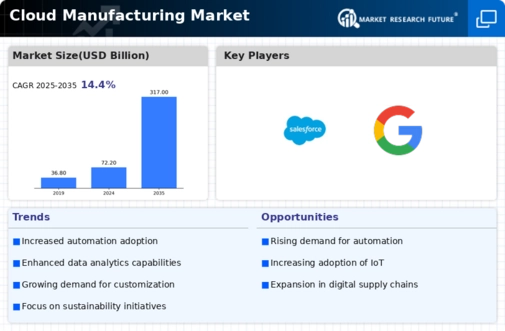Market Growth Projections
The Global Cloud Manufacturing Market Industry is projected to experience substantial growth over the coming years. With a market size expected to reach 72.2 USD Billion in 2024 and further expand to 317.0 USD Billion by 2035, the industry is on a robust growth trajectory. This growth is underpinned by a compound annual growth rate (CAGR) of 14.39% from 2025 to 2035. Such projections indicate a strong demand for cloud manufacturing solutions as companies seek to enhance efficiency, reduce costs, and innovate in their production processes. The market's expansion reflects the increasing reliance on cloud technologies across various manufacturing sectors.
Globalization of Supply Chains
The globalization of supply chains significantly influences the Global Cloud Manufacturing Market Industry. As businesses expand their operations internationally, they require cloud solutions that facilitate seamless collaboration across borders. Cloud manufacturing platforms enable real-time communication and data sharing among global partners, enhancing supply chain visibility and agility. This interconnectedness allows manufacturers to respond swiftly to market changes and optimize their production strategies. The trend towards globalization is expected to further propel the market's growth, as companies increasingly recognize the advantages of cloud-based solutions in managing complex supply chains.
Increased Demand for Customization
The Global Cloud Manufacturing Market Industry experiences a notable surge in demand for customized products. As consumers increasingly seek personalized solutions, manufacturers are compelled to adopt cloud-based technologies that facilitate rapid design changes and production adjustments. This trend is exemplified by companies utilizing cloud platforms to streamline their supply chains and enhance responsiveness to market needs. The ability to offer tailored products not only improves customer satisfaction but also drives revenue growth, contributing to the projected market size of 72.2 USD Billion in 2024. This customization trend is likely to play a pivotal role in shaping the industry's future.
Integration of Advanced Technologies
The integration of advanced technologies such as IoT, AI, and big data analytics is transforming the Global Cloud Manufacturing Market Industry. These technologies enhance operational efficiency and enable predictive maintenance, thereby minimizing downtime. For example, manufacturers can utilize IoT sensors to gather data on machine performance, which can be analyzed in the cloud to forecast maintenance needs. This proactive approach not only reduces costs but also improves product quality. The ongoing adoption of these technologies is likely to drive the market's compound annual growth rate (CAGR) of 14.39% from 2025 to 2035, reflecting the industry's commitment to innovation.
Cost Efficiency and Resource Optimization
Cost efficiency remains a critical driver in the Global Cloud Manufacturing Market Industry. By leveraging cloud technologies, manufacturers can optimize resource allocation and reduce operational costs. For instance, cloud solutions enable real-time monitoring of production processes, allowing companies to identify inefficiencies and implement corrective measures swiftly. This optimization leads to significant savings in both time and money, fostering a competitive edge. As the industry evolves, the potential for cost reduction is expected to attract more players, thereby contributing to the anticipated growth of the market to 317.0 USD Billion by 2035.
Sustainability and Environmental Considerations
Sustainability is becoming a central focus within the Global Cloud Manufacturing Market Industry. Manufacturers are increasingly adopting cloud technologies to reduce their environmental footprint and enhance sustainability practices. For instance, cloud-based systems can optimize energy consumption and minimize waste during production processes. Companies are also leveraging cloud platforms to track and report on sustainability metrics, which is becoming essential for compliance and corporate responsibility. This shift towards sustainable manufacturing practices is likely to resonate with consumers and stakeholders alike, further driving the industry's growth as it aligns with global sustainability goals.



